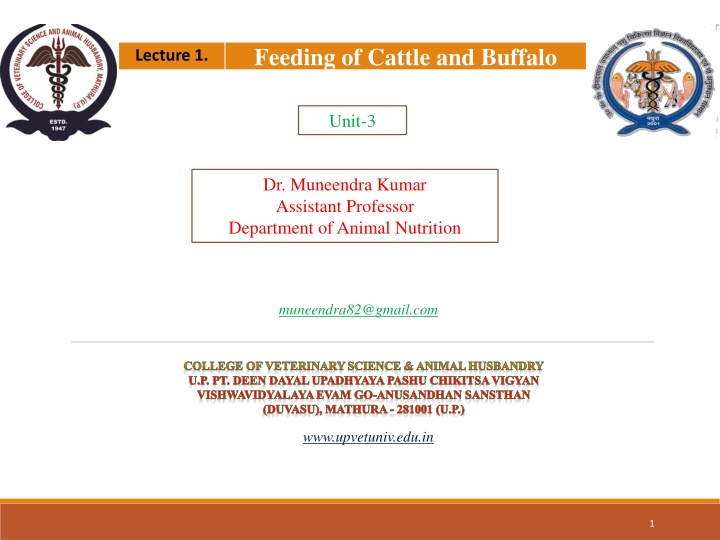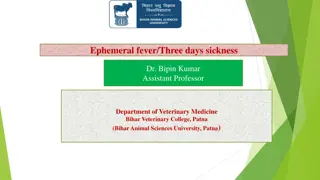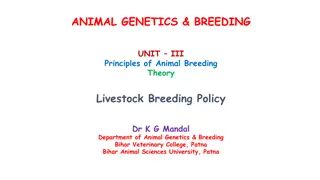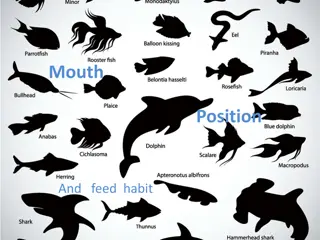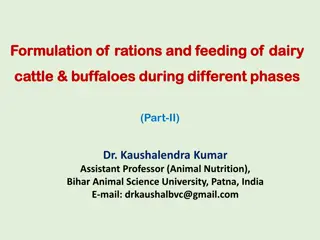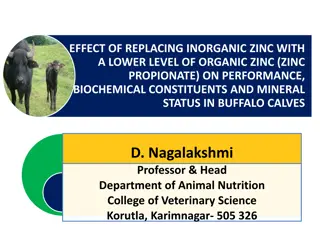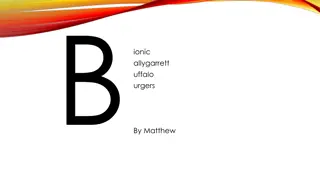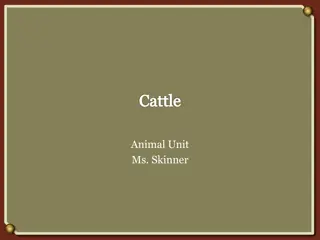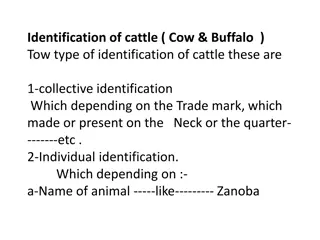Feeding of Cattle and Buffalo
Explore the key concepts of ration formulation for feeding cattle and buffalo, focusing on balanced nutrition, ingredients, characteristics of a good ration, and best practices to ensure optimal health and productivity. Learn from Dr. Muneendra Kumar, Assistant Professor at the Department of Animal Nutrition, College of Veterinary Science & Animal Husbandry, U.P. Pandit Deen Dayal Upadhyaya Pashu Chikitsa Vigyan Vishwavidyalaya evam Go-Anusandhan Sansthan (DUVASU), Mathura.
Download Presentation

Please find below an Image/Link to download the presentation.
The content on the website is provided AS IS for your information and personal use only. It may not be sold, licensed, or shared on other websites without obtaining consent from the author.If you encounter any issues during the download, it is possible that the publisher has removed the file from their server.
You are allowed to download the files provided on this website for personal or commercial use, subject to the condition that they are used lawfully. All files are the property of their respective owners.
The content on the website is provided AS IS for your information and personal use only. It may not be sold, licensed, or shared on other websites without obtaining consent from the author.
E N D
Presentation Transcript
Feeding of Cattle and Buffalo Lecture 1. Unit-3 Dr. Muneendra Kumar Assistant Professor Department of Animal Nutrition muneendra82@gmail.com COLLEGE OF VETERINARY SCIENCE & ANIMAL HUSBANDRY U.P. PT. DEEN DAYAL UPADHYAYA PASHU CHIKITSA VIGYAN VISHWAVIDYALAYA EVAM GO-ANUSANDHAN SANSTHAN (DUVASU), MATHURA - 281001 (U.P.) www.upvetuniv.edu.in 1
A ration is the feedstuff offered for a given animal during a time period of 24 hours. The feedstuffs are give at a time or in proportions at intervals (diet) A balanced ration is one that furnishes nutrients proportions and amount that it will properly nourish a given animal for 24 hours in such Ration 2
Maintenance Production Balance Ration Gestation Ideal 3
Difference Concentrate mixture/compounded concentrate/feed Concentrate mixture + Roughage 4
Concentrate mixture 1. Cereal grains-energy source-maize, jowar, bajra, rice, wheat, etc. 2. Cakes-meals/animal origin-protein source-MOC, CSK, TK, SBM, GNC/M, etc./fish meal, meat meal, bone-cum meat meal, feather meal, etc. 3. Cereal grain milling by-products-laxative and bulky-wheat bran, rice bran, rice polish, maize gluten, gram/dal chuni, etc. 4. Mineral and vitamin supplements. 5
Lecture 2 Characteristics of ration 1. Ration should be well balanced in terms of energy, protein, minerals and vitamins. 2. Ration should be highly digestible. 3. The ration should be fairly laxative to stimulate the walls of digestive track for maximum secretion and action of digestive juices. 4. Ration should be fairly bulky to satisfy the hunger of animal. 5. The ingredients composing the ration should be good and sound enough. 6
6. Ration should be free from harmful constituents. 7. A variety of feeds should be used to formulate the ration for better balance of nutrients as well as palatability. 8. Ration should be cost effective and economic. The feed ingredients used in ration formulation should be easily available and cost effective. 9. Always avoid sudden change in the diet as it upsets whole stomach resulting in digestive disturbances and reduction in productive performance. 7
10 Ration should be given to the animal at regular intervals. 11 Ration must be properly prepared. Hard grains like maize, barley, sorghum etc. should must be grounded before feeding. 12 The average particle size of diet should be 800 microns for poultry and between 650 to 750 microns for swine for better utilization of feeds. 13 In the ration formulation the crude fibre (CF) contents of diet should be adjusted between 6 to 8 %. 14 Ration must contain all limiting amino acids in balanced amount. 8
15 If feed contains antibacterial compound, the withdrawal period of that compound must be kept in mind. This is the period of time that medicated feed must be removed from pig / poultry diets before you slaughter them. 16 The ration should be formulated and fed according to the requirement of the animals. Feeding less or in excess, both are detrimental to health. 17 For better digestibility the animals should get ad libitum the clean and fresh supply of drinking water. 9
How ? Why ? BALANCE FEEDING 10
1. To explore the genetic potential of the animal by feeding a balanced ration to meet the daily nutrient requirements of the animal to perform in terms of weight gain, milk or wool production. 2. A judicious use of available feed resources is possible only through scientific feeding 11
Lecture 3 1. An understanding of the different nutrients required by livestock for different physiological functions (maintenance, growth, reproduction, milk production, wool production, etc.). 2. An understanding of the nutrient composition of different feed and fodder resources and how efficiently they are utilized by the animals. 3. Formulating balanced rations by combination of different feed and fodder resources to supply the nutrients to livestock for different physiological functions. Cost ANF Availability An understanding the inclusion level of different feeds and fodders. 12
1. Determining nutrient requirement Nutrient requirements of animals are calculated by following feeding standard guidelines. Feedings standards are the tables, which indicate the quantities of nutrients to be fed to the various classes of livestock for different physiological functions like growth, maintenance, lactation, egg production and wool growth. The nutrient requirements are generally expressed in quantities of nutrients required per day or as a percentage of diet. For dairy animals, nutrient requirements are generally expressed as separate body functions but in case of poultry and pigs, combined requirements of maintenance and other body functions are given. 13
Classification of feeding standards Comparativetype Hay Equivalent standard Scandinavian feed Unit Standard Digestible-Nutrientsystem Grouven s Wolff s Wolff sLehmann Haeckers s Savage Morrison National ResearchCouncil Indian Production-valuetype Kellner Armsby Agricultural andFood ResearchCouncil
Basis of expression of nutrients in different feeding standards Feeding standard (Country) NRC (USA) Protein Energy CP, DCP TDN, DE, NE ARC (UK) DCP,AP DE, ME SCANDINAVIA DTP FEED UNIT GERMAN DCP SE ICAR (India) D C P , C P TDN, ME CP = Crude Protein, DCP = Digestible Crude Protein, DTP = Digestible True Protein, AP = Available Protein, TDN = Total Digestible Nutrient, SE = Starch Equivalent, DE = Digestible Energy, ME = Metabolizable Energy, NE = Net Energy 15
Daily nutrient requirement calculation of cattle and buffalo (as per ICAR feeding standard-2013) First Indian feeding standard for dairy cattle is designed by Sen and Ray (1946). Sen and Ray feeding standard is based on Mid-Morrion feeding standard (1954) First revised edition of Indian feeding standard was brought by Ray and Ranjhan in year 1978. Second revised Indian feeding standard was brought by Ranjhan in year 1998. Recent ICAR feeding standard is ICAR feeding standard-2013 . 16
Maintenance Nutrient requirements of cattle and buffalo (ICAR-2013) Nutrient requirement Production Maintenance Requirement of cattle and buffalo Body weight (kg) 400 450 500 550 600 DM TDN (kg/day) ME (Mcal) CP Ca P (kg/day) (g/day) (g/day) (g/d) 8.64 9.72 10.8 11.88 12.96 3.27 3.58 3.88 4.18 4.47 11.82 12.94 14.04 15.10 16.15 436 476 515 553 591 18 20 23 25 27 8 9 10 11 12 17
Milk Production Requirement Fat% DM TDN (kg/day) ME (Mcal) Cow 1.20 Buffalo 1.58 CP Ca P (kg/day) (g/day) (g/day) (g/d) 4 0.510 0.330 96 3.2 1.8 6 0.670 0.440 124 4.8 1.8 18
Calculate nutrients requirement of a Sahiwal cow with 450 kg body weight and yielding 10 kg of milk having 4% milk fat? Maintenance nutrients requirement of a Sahiwal cow with 450 kg body weight Body weight (kg) DM TDN (kg/day) ME (Mcal) CP Ca P (kg/day) (g/day) (g/day) (g/d) 450 9.72 3.58 12.94 476 20 9 Nutrients requirement for milk production (4% milk fat) Fat% DM TDN (kg/day) ME (Mcal) CP Ca P (kg/day) (g/day) (g/day) (g/d) Cow 4 0.510 0.330 1.20 96 3.2 1.8 19
Body weight (kg)/fat % DM TDN (kg/day) ME (Mcal) CP (g/day) Ca P (kg/day) (g/day) (g/d) Maintenance requirement 450 9.72 3.58 12.94 476 20 9 Milk production For 1 kg milk with 4% fat 0.510 0.330 1.20 96 3.2 1.8 For 10 kg milk with 4% fat 5.10 3.30 12.0 960 32 18 Total 27 14.82 6.88 24.94 1436 52 20
Lecture 4 Maintenance Nutrient requirements of cattle and buffalo (ICAR-2013) Nutrient requirement for pregnancy Foetal growth Cow-Foetal growth Month of gestation DM TDN (kg/day) ME (Mcal) CP (g/day) (kg/day) 6-7 0.85 0.64 2.30 169 7-8 0.99 0.74 2.67 216 8-9 1.13 0.84 3.05 263 Ca (upto 190 days=1 g/day; 190 days onwards=10 g/day) P (upto 190 days=1.5 g/day; 190 days onwards=6 g/day) 21
Buffalo-Foetal growth Month of gestation 6-7 7-8 8-9 9-10 Ca (upto 190 days=1 g/day; 190 days onwards=10 g/day) P (upto 190 days=1.5 g/day; 190 days onwards=6 g/day) DM TDN (kg/day) 0.80 0.90 1.0 1.1 ME (Mcal) CP (g/day) (kg/day) 1.0 1.2 1.4 1.5 2.76 3.21 3.66 4.11 203 259 316 373 22
Question: Calculate the nutrient requirements of 7.5 month pregnant Hariana cow having 450 kg body weight 1. Nutrient requirement for maintenance of 450 kg cow Body weight (kg) 450 DM TDN (kg/day) ME (Mcal) CP Ca P (kg/day) (g/day) (g/day) (g/d) 9.72 3.58 12.94 476 20 9 23
2. Nutrient requirement for 7.5 months pregnancy Month of gestation DM TDN (kg/day) ME (Mcal) CP (g/day) (kg/day) 7-8 0.99 0.74 2.67 216 Ca (190 days onwards=10 g/day) P (190 days onwards=6 g/day) DM TDN (kg/day) 4.32 ME (Mcal) CP (g/day) Ca P (kg/day) 10.71 (g/day) 29 (g/day) 15 15.61 6.92 24
Nutrient requirement for growth Nutrient requirements of cattle and buffalo (ICAR-2013) BW (kg) DM TDN (kg/day) ME (Mcal) CP Ca P Weight gain (kg/day) 0.2 (kg/day) (g/day) (g/day) (g/day) 70 1.6 1.04 3.76 263 <200 kg BW = 17 70 0.3 1.8 1.16 4.19 335 Young = 9 70 0.4 1.8 1.28 4.63 406 200-300 kg BW =13 100 0.2 2.9 1.33 4.78 288 100 0.3 2.9 1.46 5.28 357 100 0.4 3.0 1.61 5.80 423 Adult=6 >400 kg BW = 8 100 0.5 3.1 1.75 6.32 487 100 0.6 3.1 1.90 6.84 549 25
Question: Calculate the nutrient requirements of 100 kg calf with average daily gain (ADG) 400 g/day BW (kg) Weight gain (kg/day) 0.4 DM TDN (kg/day) ME (Mcal) CP Ca P (kg/day) (g/day) (g/day) (g/day) 100 3.0 1.61 5.80 423 <200 kg BW = 17 Young = 9 26
2. Nutrient composition of feedstuffs Feedstuffs are subjected to different protocols of laboratory analyses like proximate analysis, detergent method of fibre analysis, Talpatra method for Ca determination, etc. for nutrient profiling. These analytical procedures are specific for a given element, compound, or group of compounds. 27
NUTRIENT COMPOSITION OF COMMON FEEDSTUFFS ME Ingredient CP (%) CF (%) EE (%) Ca (%) P (%) (Kcal/kg) 3309 Maize 9.2 3.0 3.8 0.25 0.40 Bajra 2950 12.7 4.0 3.0 0.13 0.72 Rice polish 2837 12.7 12.0 16.0 0.27 1.37 Wheat bran 1286 17.2 10.9 3.0 0.19 1.12 Soybean meal Groundnut ext. Fish meal 2300 45.0 6.0 1.0 0.36 0.90 2128 40-42 11.2 1.0 0.31 0.67 1834 43.1 2.5 6.0 7.16 2.5 28
3. Formulation of balanced rations a. Partitioning of DM Partitioning of Ration DM DM indigenous cattle is 2-2.5 kg/100 kg BW (2-2.5 %). requirement in 1/3 as concentrate 2/3 as roughage 2/3 as dry roughage 1/3 as green roughage DM buffalo/crossbred cattle/exotic cattle is 2.5-3.0 kg/100 kg BW (2.5-3.0%). requirement in 3/4 as dry roughage 1/4 as green leguminous roughage 29
Question: Calculate DM from different components of ration for a 400 kg Gir cow? 10 kg DM (2.5 %) 1/3 as concentrate =3.3 kg DM 2/3 as roughage=6.7 kg DM DM indigenous cattle is 2-2.5 kg/100 kg BW (2-2.5 %). requirement in 2/3 as dry 1/3 as green roughage=2.2 kg DM Roughage=4.5 kg DM 1/4 as green leguminous roughage=1.7 kg DM 3/4 as dry Roughage=5.0 kg DM 30
b. Formulation/computation of concentrate mixture/ compounded concentrate/feed Different methods of feed formulation 1. Pearson Square Method (Single and double Pearson Square Method) 2. Algebraic Method 3. Thumb Rule Method 4. Linear Programming or Least-cost Feed Formulation or Computer Method 5. Hit and Trial Method 31
1. Steps in Pearson Square Method i. Draw a square on left side of the page. ii. Insert the percentage of required crude protein in the middle of the square. iii. Place the basal feed with its CP% on the upper left corner and supplement feed with CP% on the lower left corner of the square. iv. Subtract the CP% in the basal feed. From CP% desired in the mixture and place the difference on the corner of the square diagonally opposite to the basal feed. This is the amount of supplement in the mixture. 32
v. Subtract the CP% desired in the mixture from the CP% in the supplement and place the difference on the corner of the square diagonally opposite to the supplement. vi. The above remainders represent the amount of two feeds in a mixture weighing equal to the sum of two remainders having a desired percentage of CP. The amounts are then converted into percent to simplify mixing. 33
Lecture 5 2. Algebraic or simultaneous equation method The equation of ingredients are used for determining the level of any one nutrient. Simple equation like A + B = 100 or A + B + C = 100 can be used for calculation of concentrate mixture. Exercise 2. Compute a concentrate mixture of 20% CP content with help of simultaneous equation from two ingredients i.e. maize grain and GNC. 35
3. Thumb Rule Method The concentrate mixture can be prepared by mixing one-third of each of cereals, oil cakes and byproducts. Broadly according to this cereal or pulse method, the concentrate mixture may also be prepared as per the following flexible formula. 37
4. Linear Programming or Least-cost Feed Formulation or Computer Method The method employed to calculate least-cost and profit maximizing rations is known as linear programming. Computer programme/software/app has been developed that allowed the calculation of optimum and least-cost rations in a matter of seconds. With the use of linear programming models, the prices of available feed ingredients as well as their nutrient contents can be considered while formulating rations. Accuracy and speed of calculation are the major advantages of computer based ration formulation. 38
Feed formulation softwares/Least Cost/Linear Programming There are number of feed formulating software's some important are: Eco-Mix, AFOS, Adifo, Win feed, Brill, etc. 39
5. Hit and Trial or Trial and Error Method CP content (kg) 30 x 0.40 = 12 50 x 0.9 =4.5 20 x 0.125 = 2.5 15 x 0.04 = 0.6 0 0 0 Total = 19.5 % 40
BIS SPECIFICATIONS FOR COMPOUNDED FEEDS FOR CATTLE S.No. Characteristic Requirement Moisture (max) Crude protein (min) Crude fat (min) Type 1 Type 2 1 2 3 11 22 3.0 7 3.0 11 20 2.5 12 4.0 BIS SPECIFICATIONS FOR COMPOUNDED FEEDS FOR CATTLE 4 Crude fibre (max) 5 Acid insoluble ash (max) 41
Feeding of concentrate by thumb rule method The livestock owner finds difficult to follow the computation on body weight basis. The following thumb rule may guide them to feed their livestock satisfactory. Thumb rule is based on practical experience rather than scientific basis. In maintenance type of indigenous and crossbred cow/buffalo, 1.5 and 2.0 kg, respectively concentrate mixture is recommended. Over and above maintenance requirement, additional 1 kg concentrate mixture is required for every 2.5 kg (40%) of milk in indigenous cow and per 2.0 kg (50%) of milk in case of buffaloes During the last trimester of pregnancy, a further quantity of 1.25 kg and 1.75 kg concentrate mixture is recommended for indigenous and crossbred cow/buffalo, respectively. 43
Lecture 6 Feeding of calf A. Colostrum or beestings, bisnings or first milk Passive Immunity in cattle is the short term immunity transfer from mother to offspring by way of colostrum or beestings, bisnings or first milk. This is very important in cattle because during pregnancy there is no transport of antibodies across the placenta. Therefore, calves have no active immune system of their own. Colostrum contains antibodies, technically called immunoglobulins (Ig), for priming the calf s immune system; in addition it has a high content of fat to provide energy to the calf. 44
Newborn calfs small intestine is permeable or open and is able to absorb the Ig contained in colostrum by the process of pinocytosis however, it can also absorb environmental pathogens that can cause diseases. For this reason, it is important that newborn calves receive colostrum as soon as possible (with 2 hours of birth) not later than 3 hours of birth. During the first 3 days of its life the calf should receive colostrum. The protein content of colostrum is 17% as against only 3.5% in normal milk. 45
The content of vitamins (A, D and E) and minerals (Ca, Mg, Fe and P) is very high in colostrum. The laxative action of colostrum helps the calf in evacuating the accumulated first faecal matter (muconium) from its intestine. Colostrum should not be warmed as due to the presence of large amount of protein. It will coagulate/clot during heating. 46
Evaluation of colostrum quality Colostrum quality depends on the content of immunoglobulins which are the proteins that convey protection against disease. 1. Colostrum should have a thick consistency and color should be yellowish, avoid feeding any colostrum that looks brown or has blood in it. Watery colostrum is of low quality and should not be fed to newborn calves if possible. If the colostrum has high content of proteins, it will be very thick. The thicker the better! Practical, but not very reliable. Visual Assessment: 47
2. Colostrometer: The colostrometer is a large thermometer-like glass instrument that measures the specific gravity of colostrum. It measures how thick a sample is, and this correlates to the Ig content of the colostrum. When the instrument floats in the green zone area, it indicates high quality colostrum, medium quality is within the yellow are and very low quality is in the red area. Practical and reliable method. High quality Medium quality Low Quality >50 mg Ig/ml Between 20-50 mg Ig/ml <20 mg Ig/ml 48
3. Brix Refractometer: The Brix refractometer is an instrument that measures sugar content in a variety of solutions and has been adapted to correlate this measurement with the content of Ig in colostrum. The reference value for high quality colostrum is 22% Brix or higher. Practical and reliable method. 49
Artificial colostrum If colostrum is not available artificial colostrum can be made as follows: Sr. No. 1 2 3 4 5 6 Ingredients Warm water Raw egg (1 ) Castor oil Vitamin A Warm whole milk Antibiotic Amount 275 ml 55 g 3 ml 10, 000 IU 525 ml 80 mg Mix well and feed at 40 degree celsius 50
